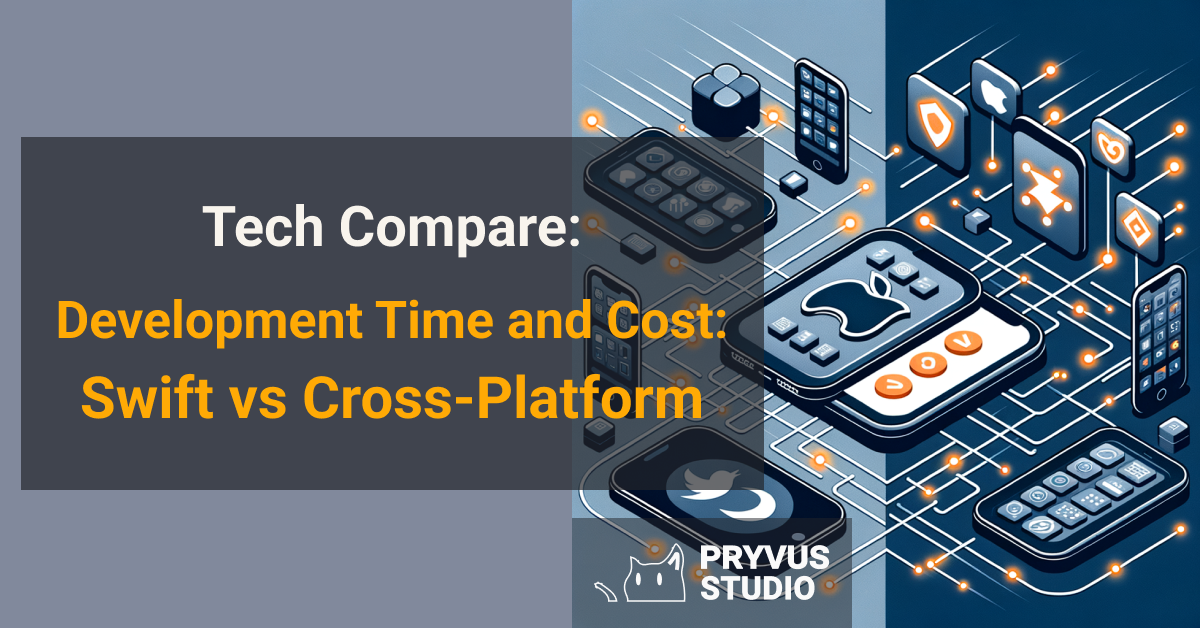
Deciding between Swift and cross-platform technologies is a pivotal choice in mobile app development.
This choice affects everything from performance to cost, shaping the future of your project. Understanding the trade-offs between Swift and cross-platform options is key to making an informed decision.
In this article, you will learn:
- Key factors in choosing development technology
- Real-world impacts of Swift vs cross-platform choices
- How Pryvus Studio can streamline your development process
Understanding Development Time and Cost: Swift vs Cross-Platform
Choosing the right technology for mobile app development is crucial. It affects not only the performance and quality of the app but also the development time and cost. With Swift for iOS and various cross-platform technologies available, making an informed decision can be challenging. Let’s dive into the specifics of Swift and cross-platform development to understand their impact on project timelines and budgets.
Swift offers a native approach with benefits in performance and user experience, while cross-platform technologies provide cost and time efficiency by using a single codebase across multiple platforms.
Swift, Apple’s powerful programming language, is designed for iOS, macOS, watchOS, and tvOS. It’s known for its speed, safety, and modern syntax that makes coding more concise. Swift’s native approach ensures optimal performance and a high-quality user experience but often involves a longer development time and higher cost compared to cross-platform solutions.
On the other hand, cross-platform technologies like Flutter allow developers to use a single codebase to create apps for both iOS and Android. This approach can significantly reduce development time and costs. However, it may result in compromises in app performance and user experience compared to native solutions.
Several factors influence the choice between Swift and cross-platform technologies. These include the app’s intended platform, performance requirements, development budget, and timeline. For businesses aiming for the iOS market with a focus on performance and user experience, Swift is the preferred choice. Meanwhile, cross-platform technologies are ideal for projects with tighter budgets and timelines, and a need for presence on both iOS and Android.
Pryvus Studio, with its expertise in both Swift and cross-platform technologies, understands the nuances of each approach. We tailor solutions to meet our clients’ unique needs, ensuring the development process is efficient and cost-effective.
Key Factors Influencing Swift and Cross-Platform Development
When deciding between Swift and cross-platform technologies, several key factors come into play. These elements can significantly sway your decision, impacting both the cost and the time required for development. Understanding these factors is crucial for making an informed choice that aligns with your project’s goals and budget.
Choosing the right development path depends on understanding the key factors that influence both time and cost.

Platform Reach: Swift is exclusive to iOS, making it ideal for targeting Apple users. However, if your goal is to reach a broader audience across different platforms, cross-platform technologies like Flutter are more suitable. This choice directly influences development time and budget, as developing for multiple platforms can be more resource-intensive.
Performance and User Experience: Swift offers superior performance and a better user experience on iOS devices. This is because it is optimized for Apple’s hardware. On the other hand, cross-platform technologies have made significant strides in closing the performance gap. Yet, they might still fall short in providing a native-like experience on all devices.
Development Cost: Initial development costs can be lower with cross-platform technologies due to the shared codebase. However, this might lead to higher maintenance costs in the long run, especially if platform-specific issues arise. Swift, while potentially more expensive upfront, can result in lower overall costs due to its stability and the efficiency of developing within a single ecosystem.
Development Time: Cross-platform technologies offer the advantage of faster deployment across multiple platforms. Swift development might take longer, especially if aiming for a polished, high-quality user experience on iOS.
Future Scalability: Considering the future scalability of your app is essential. Swift’s ecosystem provides a robust foundation for scaling an iOS app. Conversely, cross-platform solutions offer scalability across different platforms, though they may require additional work to optimize performance as your app grows.
In conclusion, the choice between Swift and cross-platform development hinges on your project’s specific needs, target audience, and budget constraints. By carefully evaluating these factors, you can make a decision that best suits your objectives.
Case Studies: Swift vs Cross-Platform in Action
When it comes to choosing the right technology for mobile app development, real-world examples can significantly clarify the decision-making process. Below, we explore case studies that highlight the differences in development time and cost between Swift and cross-platform technologies like Flutter.
Real-world case studies reveal the practical implications of choosing Swift or cross-platform technologies for app development.
Swift Case Study: A Social Media App
A leading social media company decided to revamp its iOS app using Swift to improve performance and user experience. The development took 10 months, involving a dedicated team of iOS developers. The result was a highly responsive app with advanced features, optimized for iOS devices. However, the project exceeded the initial budget by 20% due to the need for specialized skills and longer development time.
Cross-Platform Case Study: An E-Commerce Platform
An e-commerce startup opted for Flutter to develop its mobile app, aiming to launch on both iOS and Android simultaneously. This approach reduced the development time to 6 months and cut costs by 30% compared to developing separate apps for each platform. The app achieved good performance on both platforms, though it faced some challenges in delivering a native-like experience on iOS.
These case studies underscore the importance of considering your project’s specific needs, target audience, and available resources when choosing between Swift and cross-platform technologies. Swift is ideal for projects where optimal performance and a superior user experience on iOS are crucial. In contrast, cross-platform technologies are suited for projects requiring faster development and deployment across multiple platforms.
At Pryvus Studio, we understand these nuances and work closely with our clients to choose the best technology stack that aligns with their project goals, ensuring a successful and cost-effective development process.
Navigating the Challenges: Swift and Cross-Platform Development
Every coin has two sides, and so does choosing between Swift and cross-platform technologies for your mobile app development. On one hand, Swift promises seamless performance for iOS users. On the other, cross-platform frameworks like Flutter aim to simplify the development process by using a single codebase for multiple platforms. However, each approach comes with its own set of challenges that need careful consideration.
Understanding the challenges in Swift and cross-platform development is crucial for making informed decisions.

One of the primary hurdles in Swift development is the requirement of a larger team and longer timelines. This is because developing an app for iOS and then replicating it for Android demands more resources. Additionally, the need for specialized knowledge in Swift can escalate the overall project cost.
Conversely, cross-platform technologies, while cost-effective and faster in terms of development time, might not always deliver the same level of performance and user experience as native apps. The challenge here lies in finding a balance between efficiency and delivering a seamless user experience across different platforms.
Moreover, choosing the right technology depends on several factors like target audience, app complexity, and future scalability. For instance, if your app requires high-end graphics or complex calculations, Swift might be the better option. However, for apps targeting a wider audience across multiple platforms, cross-platform technologies could be more suitable.
To navigate these challenges, it’s important to partner with a developer that understands both worlds. Pryvus Studio, with its extensive experience in both Swift and cross-platform development, stands ready to guide you through this maze. Our client-centric approach ensures that we align our solutions with your business goals, helping you make the best technology choice for your project.
Making the Right Choice for Your Project
Deciding between Swift and cross-platform technologies is more than a technical decision; it’s about aligning with your project’s unique needs and goals. Whether you prioritize development speed, budget constraints, or the need for a polished user experience will guide this crucial choice.
The best technology choice balances your projects needs with development time and cost.
Swift, with its focus on iOS, might be your go-to for projects where performance and a native feel are top priorities. On the other hand, if your goal is to reach a wider audience across multiple platforms without breaking the bank, cross-platform technologies like Flutter could be the answer.
Consider Your Audience: Who are they? What platforms do they use the most? Understanding your target audience can significantly influence your decision.
Assess App Complexity: Complex apps with heavy animations or those requiring access to native APIs might fare better with Swift.
Evaluate Development Resources: Do you have the expertise in-house, or would you need to outsource? Your teams familiarity with these technologies can impact development time and costs.
Pryvus Studio, with its experience in both Swift and cross-platform technologies, stands ready to guide you through these considerations. We’ll help you make a decision that not only meets your current needs but also positions your project for future growth and success.
In summary, the choice between Swift and cross-platform development hinges on a deep understanding of your project’s requirements, audience, and resources. Making an informed decision will help you optimize both development time and cost, ensuring your mobile app’s success.
Streamlining Your Development Process with Pryvus Studio
Choosing the right technology for your mobile app development is no small feat. It’s a decision that weighs heavily on development time, cost, and the overall success of your project. Whether you’re leaning towards Swift for its performance and user experience advantages or considering cross-platform technologies for their efficiency and broader reach, Pryvus Studio is here to guide you through this crucial decision-making process.
At Pryvus Studio, we understand that every project is unique. That’s why we offer:
- Personalized consultations to align with your project goals
- Expert advice on choosing between Swift and cross-platform technologies
- Custom solutions that cater to your specific needs and budget
We leverage our extensive expertise to ensure that your development journey is not only tailored but also efficient and cost-effective. Our team is committed to helping you navigate the challenges associated with mobile app development, from specialized knowledge and resource requirements to finding the perfect balance between efficiency and user experience.
Don’t let the complexity of technology choice overwhelm you. Pryvus Studio is here to simplify the process, ensuring that you make a decision that best suits your project’s needs, goals, and target audience. Reach out to us today for a partnership that promises a streamlined development process and a successful project outcome.
Let’s make your vision a reality. Contact Pryvus Studio now and take the first step towards a successful mobile app development journey.


